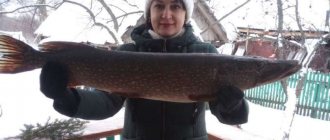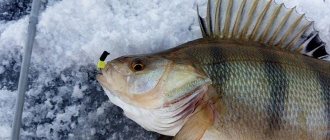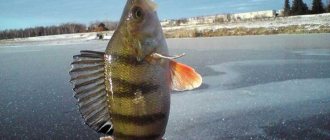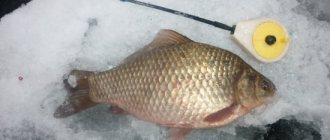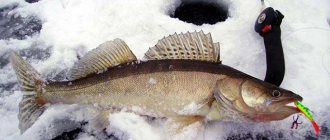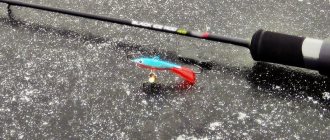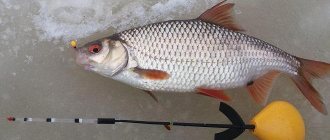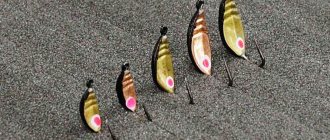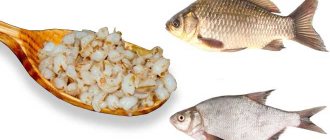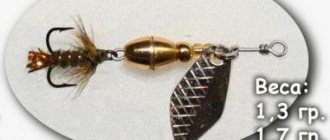Reelless baits for roach are gaining popularity among winter hunters of this fish. No-bait fishing with jigs in winter has become a separate, independent area of winter fishing. The object of such fishing is an active fish that reacts to a stimulus. The working fishing tactic is active search. Some fishermen use this method together with other gear, passing the time while waiting for a bite on a nearby float rod. Another group of fishermen uses only this gear in principle – just for fun.
Winter roach
Roach is a common trophy for baitless fish, along with perch, due to its wide distribution in water bodies. It’s not difficult to pull out a couple of roach while fishing. However, in order to count on a full catch of large fish, you need to know some features of its winter habits. An article about the features of winter fishing for roach:
No-bait roach fishing
Catching roach with a reelless jig requires some knowledge and fine fishing rod equipment, as well as a set of special baits - reelless jigs. Over the many years of development of this method of fishing, we can definitely say that the largest roach specimens are caught in winter without bait. Probably the reason for this is the greater aggressiveness of large fish, as well as the active search tactics required for this method of fishing. In the north, sorog is successfully caught using a reelless reel, and in Siberia, chebak. So the spread of such fishing is a widespread phenomenon. And every year there are more and more fans of the rewinder. An article about reelless fishing.

Lure
Roach can be caught using a reelless bait with or without bait . The second option is better suited for periods of active biting - the first and last ice and thaws in the middle of winter.
If the roach is passive and bites poorly or refuses to take the bait at all, you can stir it up with the help of bait. Its advantage is not only that it allows you to attract fish to the hole . Bait can also activate the roach and bring it out of its torpor. The fish will begin to feed, and at the same time will get hooked.
In general, it is more logical to catch roach with a reelless bait without bait, and to feed them when fishing with a jig with bait, a float or a winter feeder. But feeding during reelless fishing justifies itself, allowing you to get the best catches.
Tactics
As already mentioned, the main tactic is active search. But this statement is more relevant for the beginning and end of winter, when the fish are active, and fishing does not even require bait. Let's take a closer look at how to catch roach in winter using a reelless reel in different time periods.
In the dead of winter, each hole is carefully fished, maybe even fed and hatched until the fish become active. After all, the absence of bites during this period does not mean that there are no fish under the hole. During this period, the roach may simply not take the bait, but stand nearby in an inactive state. In such cases, if there is confidence that the fish are clearly here (for example, they are biting at bloodworms from neighboring fishermen), the holes are supplemented with food, the bait and game are changed - and often this bears fruit. During the deep winter period, it is better to use the usual fishing tactics with baited jigs or fishing rods with a float - drill several holes, bait and then fish thoroughly, changing reelless baits and fishing methods until you find a catchable option. In this case, bait can activate the fish, forcing it to feed.
On the first ice, the roach takes the reeler boldly, the main thing is to find the right place. This also happens at the end of winter, when the fish begins to feed intensively, preparing for spawning. At this time, you should not sit on one hole. No bites - we move on. At this time, you can count on bites at shallow depths, near the grass along the shores and islands, but in the middle of nowhere - in deep places, up to 2-6 meters.
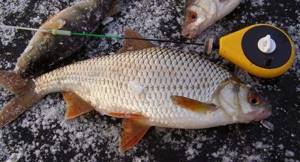
Features and techniques
How to prepare bait for roach with your own hands
You can use a rewinder when fishing for roach from the very first days of winter. As soon as safe ice is established on reservoirs, this direction begins to show stable results. Unlike perch hunting, “baitless” allows you to cut off outright small things, increasing the quality of the catch.
Conventionally, fishing with a baitless jig can be divided into three main periods:
- first ice;
- wilderness;
- last ice.
Each time period has its own characteristics and nuances. Let's look at them in detail.
On the first ice
At the beginning of winter, roach behaves actively. The fish readily responds to the offered jigs, is not picky, and reacts to various animation techniques. More often it is caught interspersed with the ubiquitous perch, which moves throughout the entire water area and greedily pounces on fishermen’s baits.
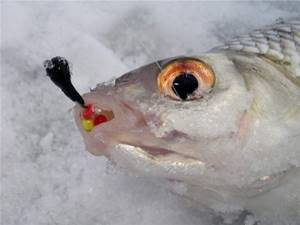
On the first ice, the roach readily responds to the mothless bait.
The best places to look for roach on the first ice are:
- shallow coves and bays;
- oxbow lakes and branches from the main river bed;
- coastal zone with slow current;
- upper reaches of reservoirs;
- any shallow water areas on lakes and quarries.
At the beginning of winter, roach tries to stay at depths of up to two meters. As a rule, the fish stays near the bottom. Sometimes it rises to the middle horizons. Doesn't happen at all near the surface.
When fishing for roach during this period, the angler should not sit for a long time on one hole. Even staying within a limited area is irrational. Active fish will always show themselves, and if there are no bites after three or four lifts of the jig, then you should immediately move to another promising point.
The most effective movements of jigs along the first ice are various feeds with a high oscillation frequency. If such an animation brings a small number of bites, then it is advisable to introduce periodic short stops into it. Often this technique works positively, increasing the number of effective contacts between roach and bait.
Of the jigs, preference should be given to the following types:
- pellet;
- oatmeal;
- ant;
- Uralka.
The jigs are selected small, weighing 0.1–0.3 grams. Color black, gold or copper. Additional equipment with moving elements is welcome, but for the first ice a small bead of a contrasting color will be enough.
In January and February
Towards the middle of winter, death phenomena begin in many reservoirs due to deteriorating oxygen conditions. This period among fishermen is called the wilderness and is considered the most difficult in terms of approach to fishing. The Mothless is no exception. You have to try hard to provoke the roach to bite confidently.
In the wilderness, especially in February, fishing technique comes to the fore, in particular, the variability of jig movements and the ability to use them depending on the situation. By changing the frequency of oscillations, the speed of rise, and the duration of pauses, an experienced fisherman manages to force the fish to grab the bait.
Advice! When fishing in the dead of winter, the duration of stops can reach up to ten seconds. Be sure to fish with a stop at the top point of the rise of the jig.
In the middle of winter, preference should be given to baits equipped with various additional elements that create a noise and visual effect, affecting all the senses of the fish. The best options for roach baitless jigs are:
- Beads and beads, especially of contrasting colors in relation to the body of the jig. The most popular colors are red, black, yellow and white. Some fishermen like to use so-called watermelons.
- Colored cambrics. As a rule, they are always used, since they fix other elements of the bait well, preventing them from slipping off the hook shank.
- Chain. From three to ten links are used. They can be secured at one end or in the middle.
- A regular thread of red, yellow, black or white, which is tied in a knot on the shank of the hook.
- Sequins or similar discs. You can use from one to several pieces.
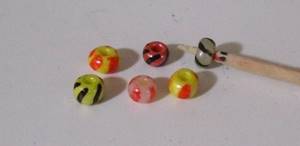
The roach really likes the watermelon bead.
All of the above elements can be combined with each other. The fisherman can use all his imagination, creating various combinations of bait and any colors. However, you cannot overdo it so as not to completely ruin the game of the jig. Before fishing, the collected bait must be tested in a jar of water at home.
On the last ice
At the end of winter, the roach becomes more active and begins to feed well, readily responding to baitless jigs. Despite the fact that the belly of the fish is filled with caviar, it prefers medium and large-sized baits with various pendants listed above.
Winter fishing for roach with a reelless reel on the last ice is carried out with the following jigs:
- ant,
- banana,
- nymph,
- goat,
- oatmeal.
Often, anglers use the devil, which, with the proper approach, can compete with other varieties of jigs.
Advice! We recommend paying attention to a baitless bait called an “earring”. This is a nymph or another type of jig with an interesting suspension option. The roach responds very well to it.
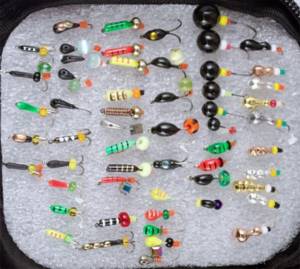
The roach kit must be equipped with a variety of nozzleless jigs.
The roach takes well on the last ice. Idle bites are rare. The fish attacks the jig confidently, without hesitation, pressing the nod down. If the fisherman managed to find the zone of its localization, then he can spend the whole day there, catching many commercial specimens.
Tackle for catching roach without a reel
The success of winter fishing for roach with a reelless reel strongly depends on correctly assembled gear and the angler’s ability to use it. After all, a baitless jig must always be in motion; there are no bloodworms or other bait on the hook that attracts fish. Success is based on the correct action of the reelless bait, and, in addition to the movements of the angler's hand, this is ensured by fine tuning of the nod.
Reelless fishing rod
For this kind of fishing you need a light fishing rod. Fishing rods for baitless fishing are divided into two types - nod and nodless. A nockless fishing rod is an ultra-light tackle; some craftsmen make fishing rods weighing 1.5 grams. The bite on such fishing rods is transmitted to the hand. This is a new direction, but it is developing rapidly. Fishermen love this tackle because there is no need to bother with fine-tuning the nod. Other anglers see a disadvantage here - tackle with a nod allows you to perform a more varied game. The nodless option is more suitable for fishing at the beginning and end of winter for active fish. In the dead of winter, a gentle bite without a nod may not be noticed.

Rewinder equipment
Reelless fishing rods for roach are equipped with thin lines and small baits. The best option is a fishing line with a diameter of about 1-0.12 mm. You can use fluorocarbon or nanofil, which is invisible in water, naturally using special units for these materials. The assembled tackle is light and balanced.
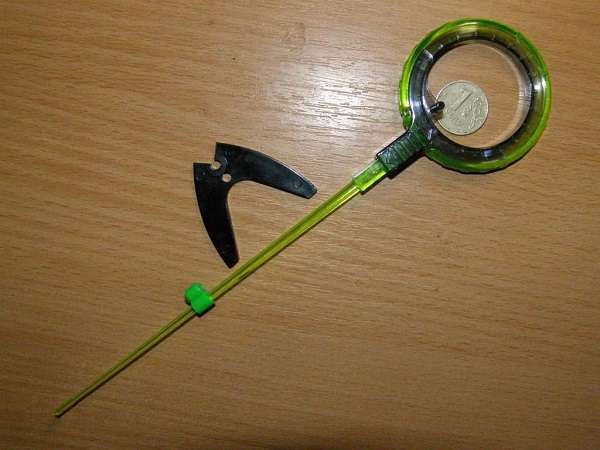
Nod
Using a reelless jig for roach requires careful adjustment of this element of the equipment from the nodding tackle. The nod for the reeler is not just a bite signal, it ensures the correct action of the bait. This issue is discussed in detail in the article about catching this fish with jigs:
Roach loves slow, smooth movements, but not as much as when playing with bream. It requires a nod that is less flexible than for catching bream, and not elastic, like for perch. In the air, the jig should evenly bend the guard to a quarter of a circle. A separate nod is used for each weight of the rewinder. Only in this case is the maximum return of the rig in the game with bait obtained.
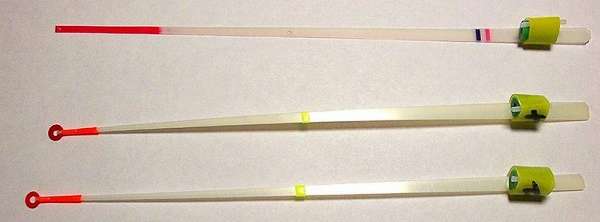
Since small baits are used for roach, metal guards are not suitable for such fishing. The best option is special nozzles for nozzles, store-bought or homemade, made of lavsan, polycarbonate, boar bristles or other similar soft and elastic materials. It is better to have several fishing rods in your arsenal, already equipped and optimized in terms of the ratio of fishing line diameter, selected nod and bait weight, which will allow you not to have to adjust and re-tie gear on the pond. You need to change the jig - take a fishing rod, already set to a certain weight, and tie on the selected bait (which are also laid out in the box, according to the scales). This point is relevant for reelless, since it happens that during a fishing trip you need to try out a lot of jigs until a working one is found at exactly this time and in this place.
How to choose a rewinder
To catch roach from ice, you can successfully use a variety of reelless baits - almost all of them that are on the shelves. If the task is to assemble an initial collection, you should pay attention to the following models:
- pellet;
- a drop;
- oatmeal;
- ant;
- Ural;
- banana;
- nymph;
- goat;
- little devil
To catch roach, small reelless reels are used , less often - medium-sized ones. Standard weight – 0.1-0.3 g.
Silver rewinders
are very popular But, besides them, you should definitely add jigs of golden, copper and black light to your arsenal. Important. The quality of the hole for the line and the hook is very important. Beginners often don’t pay attention to this point, and as a result, they don’t get enough catches. It’s good if you have the opportunity to carefully examine the models you like before buying them.
Reelless jigs for roach
Every winter-driving fisherman is looking for the best baitless reel for roach. But there are no such baits. There are only workers, catching roaches without rewinders, but they are such only at a certain time and in a specific place. A fisherman's arsenal should include a variety of baits of various types, colors and weights. The best reelless baits for catching roach are such only at a specific moment in time on a particular body of water, and the fisherman’s task is to find during the fishing process the option that will work today, coupled with the correct action of the bait. The shapes of baits are varied, they have different decorations and holes in the body , color options are also varied.
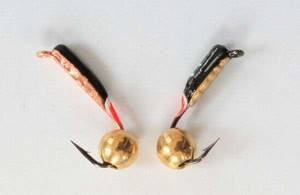
You shouldn’t chase the brightest and most beautiful ones; what’s more important is the quality of the hook and the hole for attaching to the fishing line. In the set you need to have various baits for a variety of fishing conditions, which will provide a greater likelihood, especially in low-biting conditions, to pick up something that will tempt the fish to bite. Craftsmen make reelless jigs for roach with their own hands, or remake factory jigs. Sometimes you can see real handmade masterpieces that you would never find in a store.
Roach bite on the first ice
Catching roach in the first ice will be effective at stable atmospheric pressure, when there are no sudden changes. It is good to plan fishing when the pressure readings slowly decrease from high to low, from 742 to 737. Weather conditions have the most direct impact on underwater inhabitants.
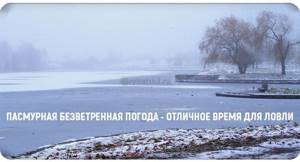
The fish become more active on cloudy days when there are no strong gusts of wind. It bites better in light wet snow and thaw. You shouldn’t expect bites in frosty weather or when the atmospheric pressure “jumps”; the roach is passive on such days.
There are no specific hours here based on the time of day; the fish in this regard is unpredictable on the first ice. It is optimal to go hunting around noon and fish until 4 pm.
Mothless decorations
On a mothless hook, instead of a bloodworm, artificial irritants are used, which serve as an attack point for the roach. There is a huge variety of these elements - beads, cambrics, chains, balls, etc. There is debate among fishermen about what color of beads roaches prefer in winter. There is often an opinion that in the first half of winter, combinations of white and black colors work better (roaches, in principle, love white), and closer to spring, dark green and dirty brown tones are better. Of course, this is not a rule, and it can work completely differently in different bodies of water. They are caught using reelless baits with red beads, yellow beads, and many other colors. It all depends on the preferences and tastes of the fish in a particular body of water.
Fishermen note that reelless baits with whiskers - a pair of threads attached to a hook - work well. During the period of activity, the fish willingly goes for knocking, with all kinds of nail cubes and nail balls, which have been gaining popularity lately. Of course, their supposed “super catchability” is outright marketing, but these baits cannot be denied, they really perform well on reservoirs

Jigs for zebra mussel and uralka roach
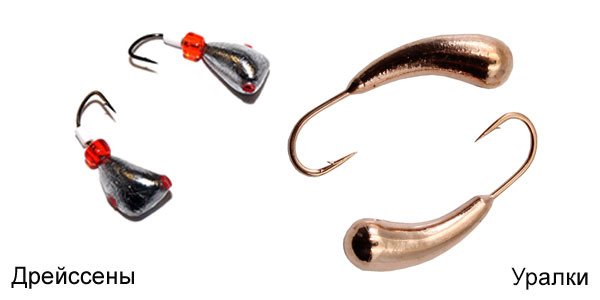
If we talk specifically about the best reelless baits for catching roach, then the classic baits that naturally copy the natural prototypes that roaches are used to feeding on come to the fore, especially for a beginner. Such jigs include the classic “Dreissena” and “Uralka”.
The weight of the zebra mussel, as a rule, averages 0.6 g. And since roach is usually caught at depths of two to four meters, such a jig paired with a 0.10 mm fishing line will play very well.
The animation is simple: first, we lightly tap the jig on the bottom soil, then, giving slight vibrations, we lift the bait up. The zebra mussel jig does not require sophisticated play with a high number of vibrations; on the contrary, a leisurely, measured game with a small number of vibrations, 2-4 per second, most often helps out.
Fishing tactics
If the roach reacts well and the bite is active, then the nod should be kept parallel to the ice, in which case it is easier to achieve the desired oscillation frequency. During the rise, when the jig moves 50-60 cm from the bottom, we pause for 2-3 seconds, and after it we make a control hook. It is strongly recommended to carry it out, because at such moments very often the roach tries to grab the jig. For each individual case, you need to find an effective game, and when there are no bites, it is worth increasing the number of oscillations, while reducing the amplitude.
This can be achieved by lowering the end of the nod down almost vertically. In this case, the vibrations will go more horizontally, and the blende will tremble in a peculiar way. But whatever the game of the zebra mussel, it is very important to make stops and pause for two or three seconds, since it is precisely such stops in the game that provoke the fish to grab.
A very good way to diversify the game is to sharply drop the reelless bait from a height of 50-70 cm and stop before reaching the bottom a couple of centimeters, followed by the bait completely freezing for a few seconds. This feint is very good when a bead is installed on a hook without a reel, and at the moment of stopping it continues to move slightly along the shank of the hook, thereby attracting roach.
There are a lot of wiring options when fishing with a reelless bait!
At the moment the roach bites, the nod stops or is pressed, but very unexpected blows also occur. It is advisable to carry out hooking in case of any suspicious behavior of the nod, since when fishing with a reelless roach, the roach can very quickly understand the deception and spit out the jig.
In some cases, it is better to start playing with a low vibration frequency. In the case when there are few bites or none at all, it is advisable to gradually increase the frequency of oscillations and find the best method of play that will lead to bites. With this reelless reel you can catch roach, both with and without bait, relying more on active searching.
Real fishing experience eloquently shows that it is free search that is more effective when fishing with zebra mussels, and with any other reelless bait. It is important to remember here that roaches like to gather in areas that are rich in natural food, and a significant part of it is the natural mollusk - zebra mussel. Experienced fishermen have noticed that at such points the fish like to eat their natural food and practically do not pay attention to plant bait. Therefore, it is not always worth using it.
When fishing with zebra mussels, you should pay attention to one important circumstance. The fact is that a real mollusk has a very hard shell, and large roaches have learned to open it with their rather powerful pharyngeal teeth. Therefore, this fish often breaks weak, low-quality hooks on a jig, and it is very important to take care and check the reliability of the hook.
To make it more attractive, as a rule, the zebra mussel is decorated with beads that move freely along the shank of the hook. They also praise the option when the bead runs along the main line higher than the jig. A successful combination for roach is a yellow and red bead on the hook itself and a purple one on the main line, directly above the bait.
In addition to the zebra mussel, the Uralka jig is excellent for successfully mastering baitless fishing. This reeler is most suitable for hunting roach in shallow water areas.
Nod to the rewinder
The methods described above are also suitable for mastering the Uralka. But the nod plays a fundamental role. Mystery nods or plate-shaped polycarbonate models that have a loop or hole at the tip for passing line through are the best options. The main thing is that the nod is sufficiently elastic and has minimal tip weight to reduce the number of its own vibrations. When selecting a nod for the used jig, it is important to pay attention to the fact that the angle of inclination of the nod under the weight of the jig does not exceed thirty degrees.
Some fishermen prefer to do it a little differently; they bend the nod towards the top, to do this they run the back of the knife along the plate with a little effort. But being in the working position, under the weight of the rewinder, the plate straightens. Fishermen claim that with this option it is easier to achieve effective animation and it is more comfortable to switch from one option to another.
Previously in reviews:
The correct selection of a nod from M. Efimov, world champion in winter fishing,
Catching roach with devil in winter
Devil is a common nozzle-free jig. It differs from other baits by the presence of three hooks at the bottom. There are many variations of this bait. Fishing with the devil is done using the smallest versions of this jig. For fishing at depth, a compound devil is used. There are even plastic floating devils. The hooks are equipped with multi-colored beads, the body of the bait is covered with black paint, and can also be equipped with brass or copper plates.
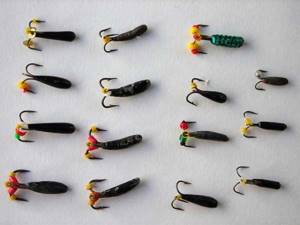
Some fishing secrets
To ensure that going out onto the reservoir on the first ice has not only the effect of “creating beauty”, but also meaning, adhere to the following recommendations:
- are not afraid to experiment with baits (it’s worth trying bright colors);
- follow the rules of masking, especially on sunny days;
- for night fishing, choose small jigs with luminous elements (phosphorus droplets on the body);
- give working holes periodic “rest”;
- after feeding the hole, at least half an hour should pass before fishing begins;
- When weather conditions change, fish all layers of water.
Catching chebak on the first ice with a jig gives good results. The main thing is to know where to look and what to attract. And pay special attention to camouflage issues, otherwise it will be easy to scare away prey on transparent ice.
Nail cubes and nail balls
According to generally accepted opinion, nails with large balls are good working reelless jigs for roach. Their peculiarity is the presence of a heavy element on the hook, which taps the forearm and body of the bait when playing, and also attracts fish with color. Some fishermen believe that such baits are the best reelless baits for roach. Recently, a cat's eye bait (or a vigorous eye) has become a popular bait for roaches. The jig received this name because of the large ball on the hook of a characteristic green color.
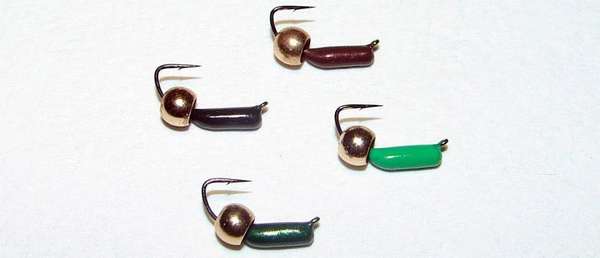
Reelless fishing
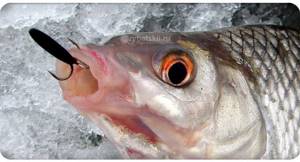
Catching sorog on the first ice using a reeler is quite effective; you can catch large specimens. But the tactics used must be well chosen, then you can count on the activity of the fish. When playing with a jig, the fisherman has no restrictions; everything depends on a creative approach. For greater efficiency, also use a live bait, then the process will become even more fun.
Ant and nymph
These are classic rewinders that have proven themselves over years of practice. Many fishermen prefer these baits. Thanks to their thicker upper part (and heavier weight), these reelless lures have a nodding action that is attractive to roaches. Active fish do not refuse them; beginners are recommended to start learning the basics of baitless fishing with these baits.
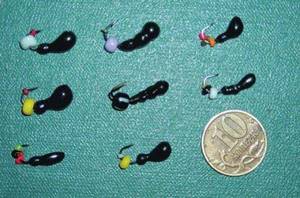
Classic jigs for rewinding
Catching roach in winter with a reelless bait is also done using ordinary baits that have long been tested by anglers. Uralkas, oats, droplets, cloves, poles - all this is successfully used for baitless fishing, it’s just that instead of bloodworms, the hooks are equipped with artificial attracting elements. A heavy reelless zebra mussel for catching large roach at depth also copes with this task. According to many fishermen, these are the best reelless reelers, since they have already shown good results over many years.
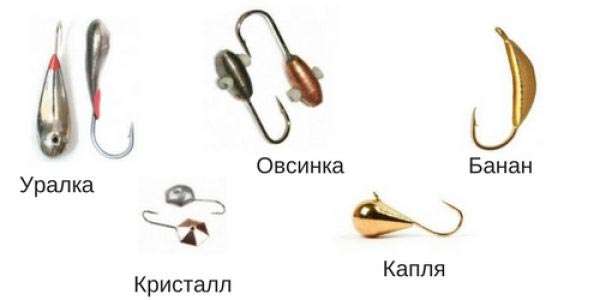
Advantages of reelless fishing
Anyone who has seriously decided to master the reelless method of fishing from ice must approach this issue thoroughly. There are no trifles in such a difficult fishing direction. But many opportunities and advantages open up for the fisherman:
- fishing in water areas without current, slow and moderate flow;
- the ability to fish at depths from 30 cm to 5–6 meters;
- a wide range of jigs and techniques for feeding them;
- works throughout the winter season, especially on the last ice;
- high dynamics of fishing, the need to constantly search and move around the reservoir.
A baitless jig is the best way to catch large roach. Some experienced fishermen purposefully use reelless fishing to hunt trophy fish.
